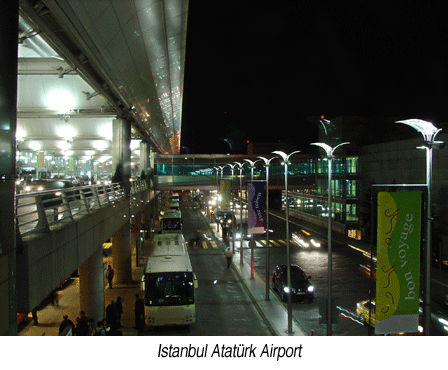 Can
Turkey Grow Can
Turkey Grow
Trade & Cargo?
Although the Turkish economy slid into
recession, in 2009 in part due to the steep decline in overseas trade
and a falling off in domestic demand, there was no financial collapse
as occurred during the downturn of 2001, with the banking sector not
only surviving but also prospering and the stock market riding a wave
of growing activity.
That said, Turkey remains in negative
territory and unlike some of Europe's big economies, such as Germany
and France, it may take a bit longer to move out of recession, with
many experts predicting a return to growth in the second half of the
year.
While final year-end results have yet
to be released, most indications show that the Turkish economy will
have contracted by around 6.5% in 2009, after a 1% increase the year
before.
Though a marked retreat, an improved
regulatory environment, swift interventions by the Central Bank and
some measures applied by the state helped to avoid the worst-case scenario.
The increasing resilience of the Turkish
economy was reflected in a decision by ratings agency Moody's early
in the new year to upgrade the country's rating and outlook from Ba3
to Ba2, and from stable to positive, respectively. According
to the agency, the upgrade was based on the increased confidence in
Turkey's ability to absorb shocks, access to funding and negate the
effects of recession.
 The
strong performance of public finances compared to previous economic
crises was notable, said Moody's analyst Sarah Carlson on January 8. The
strong performance of public finances compared to previous economic
crises was notable, said Moody's analyst Sarah Carlson on January 8.
"The ability of the government and
the country more generally to regroup when faced with a very significant
economic and financial challenge indicates that Turkey has reached a
higher level of resiliency, which is what our ratings ultimately reflect,"
she said.
Turkey's stock market was not just resilient
but positively buoyant, with the Istanbul Stock Exchange's main share
index bouncing back from losses in the second half of 2008 to post a
97% increase on the year.
The country's banking sector also had
a stellar year, cashing in on the Central Bank's monthly interest rate
cuts with net profits for Turkey's banks rising by 44% to $12.6bn in
the 11 months ending November, while their combined assets climbed by
11.5% to $544bn. However, Turkey's lenders did not pass on the reserve's
rate reductions, with the bank's loan activity increasing by a far more
modest 4%, with just $260bn disbursed.
Though Turkey saw the brakes put on its
export trade, with overseas sales needing a late surge in December to
push them through the $100bn mark, the overall performance was better
than forecast earlier in the year, when some analysts were predicting
a top-range figure of below $90bn. The climb in exports was in part
driven by some of Turkey's major trading partners, notably those in
Europe, moving out of recession in the latter months of 2009. Imports
were also down for the year, coming in at just under $140bn, equivalent
to approximately 30% fall due in part to lower oil prices and weakened
consumer demand.
There are some causes for concern heading
into 2010, one of which is increasing inflationary pressures, with year-end
consumer inflation coming in at 6.5%, with wholesale prices rising by
5.9%. Though well down on the 10% increase recorded by the consumer
price index in 2008 and the 8.1% for producer prices, many analysts
had expected a better performance. With inflation hitting a 10-month
high in December and the government hiking costs on a number of core
goods and services at the beginning of 2010, the outlook is for prices
to trend upwards throughout the year.
The rise in inflation late in the year
prompted the Central Bank's monetary policy committee to end its monthly
round of interest rate cuts, the reserve keeping its key borrowing rate
at 6.5% at its December 17 meeting. This followed 13 reductions over
the previous 12 months that saw the bank's rate fall from 16.75% to
historically low levels.
Though inflation has eased and the economy
appears to be moving out of recession, unemployment has remained stubbornly
high, defying state-backed efforts to promote job creation and preserve
existing positions. Despite providing tax breaks for both the automotive
sector and the white goods segment, aimed at stimulating sales and propping
up two of Turkey's key sectors, the government was unable to plug the
hole draining away jobs. By late in the year, the unemployment rate
had risen to 13.4%, up from the 11% of 2008, with the best hopes for
a turnaround being a major increase in activity in the manufacturing
sector.
Throughout the year, the economy managed
to shrug off concerns swirling around alleged coup plots by retired
military officers, calls for early elections and ongoing low-level terrorist
activity, mainly in the country's south-east. In years past, such issues
could have caused ripples in the economy, though it seemed that in 2009,
Turkey had matured somewhat and was better placed to ride out both domestic
and international storms.
Gordon Feller |



